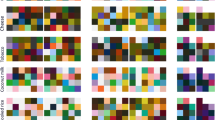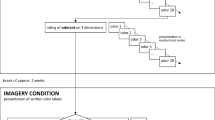Abstract
Introduction
In the present study, we assessed crossmodal associations between odors and both color and shape, with particular interest in the principles beneath these mappings. We hypothesized that visual associations of odors would primarily reflect observable features of a smelling object and thus vary with different source assumptions of the very same smell.
Methods
We asked 30 participants to visualize their odor associations on a drawing tablet, freely deciding on color and shape. Additionally, subjects provided ratings on perceptual and shape-related dimensions as well as a verbal label for each sample.
Results
With respect to color selection, the results confirmed a source-based mapping approach: odors rated as familiar were associated with very particular colors that typically resembled the appearance of their source. For less familiar odors, color selection was rather inconsistent but still then went along with assumed odor objects. Shape ratings changed with odor identifications as well, but considerably less than for color associations. Shape ratings and shape drawings produced very different results. While shape ratings were unlikely rooted in the mental imagery of a shape, drawings frequently displayed concrete objects that depended on odor label.
Conclusions
Results confirm the existence of stable odor–vision correspondences and suggest that language plays a major part in mediating these mappings. The frequently assumed hedonic foundation of crossmodal matchings could not be confirmed for this stimuli set.
Implications
Odor sensations may trigger odor naming spontaneously. Assumptions about an odor’s identity, as well as the multisensory knowledge we have acquired on it, affect the visual associations of an odor.








Similar content being viewed by others
References
Blackwell L (1995) Visual cues and their effects on odour assessment. Nutr Food Sci 95:24–28
Cain WS (1979) To know with the nose: keys to odor identification. Science 203:467–470
Cain WS, Potts BC (1996) Switch and bait: probing the discriminative basis of odor identification via recognition memory. Chem Senses 21:35–44
Cain WS, de WR, Lulejian C, Schiet F, See L-C (1998) Odor identification: perceptual and semantic dimensions. Chem Senses 23:309–326
Charney, S., Levitan, C.A., Palmer, S.E., &Schloss, K.B. (2015). The smell of jazz: crossmodal correspondences between music, odor, and emotion. CogSci
Chrea C, Valentin D, Sulmont-Rossé C, Ly Mai H, Hoang Nguyen D, Abdi H (2004) Culture and odor categorization: agreement between cultures depends upon the odors. Food Qual Prefer 15:669–679
Collier GL (1996) Affective synesthesia: extracting emotion space from simple perceptual stimuli. Motiv Emot 20:1–32
Crisinel A-S, Jacquier C, Deroy O, Spence C (2013) Composing with cross-modal correspondences: music and odors in concert. Chem Percept. 6:45–52
Crisinel A-S, Jones S, Spence C (2012) ‘The sweet taste of maluma’: crossmodal associations between tastes and words. Chem Percept. 5:266–273
Crisinel A-S, Spence C (2010) As bitter as a trombone: synesthetic correspondences in nonsynesthetes between tastes/flavors and musical notes. Atten Percept Psychophys. 72:1994–2002
Dematte ML, Sanabria D, Spence C (2006) Cross-modal associations between odors and colors. Chem Senses 31:531–538
Deroy O, Crisinel A-S, Spence C (2013) Crossmodal correspondences between odors and contingent features: odors, musical notes, and geometrical shapes. Psychon Bull Rev 20:878–896
Desor JA, Beauchamp GK (1974) The human capacity to transmit olfactory information. Percept Psychophys 16:551–556
Dubois D, Rouby C (2002) Names and categories for odors: the veridical label. In: Rouby C, Schaal B, Dubois D, Gervais R, Holley A (eds) Olfaction, taste, and cognition. Cambridge University Press, Cambridge (GB), pp 47–66
Engen T (1972) The effect of expectation on judgments of odor. Acta Psychol 36:450–458
Ferdenzi C, Roberts SC, Schirmer A, Delplanque S, Cekic S, Porcherot C, Cayeux I, Sander D, Grandjean D (2013) Variability of affective responses to odors: culture, gender, and olfactory knowledge. Chem Senses 38:175–186
Fiore AM (1993) Multisensory integration of visual, tactile, and olfactory aesthetic cues of appearance. Cloth Textiles Res J 11:45–52
Gilbert AN, Martin R, Kemp SE (1996) Cross-modal correspondence between vision and olfaction: the color of smells. Am J Psychol 109:335–351
Hanson-Vaux G, Crisinel A-S, Spence C (2013) Smelling shapes: crossmodal correspondences between odors and shapes. Chem Senses 38:161–166
Jacquot M, Noel F, Velasco C, Spence C (2016) On the colours of odours. Chem Percept. 9:79–93
Kaeppler K, Mueller F (2013) Odor classification: a review of factors influencing perception-based odor arrangements. Chem Senses 38:189–209
Kemp SE, Gilbert AN (1997) Odor intensity and color lightness are correlated sensory dimensions. Am J Psychol 110:35–46
Knöferle K, Spence C (2012) Crossmodal correspondences between sounds and tastes. Psychon Bull Rev 19:992–1006
Lavin JG, Lawless HT (1998) Effects of color and odor on judgments of sweetness among children and adults. Food Qual Prefer 9:283–289
Levitan CA, Ren J, Woods AT, Boesveldt S, Chan JS, McKenzie KJ, Dodson M, Levin JA, Leong CXR, van den Bosch JJF (2014) Cross-cultural color-odor associations. PLoS One 9:e101651
Majid A (2015) Cultural factors shape olfactory language. Trends Cogn Sci 19:629–630
Majid A, Burenhult N (2014) Odors are expressible in language, as long as you speak the right language. Cognition 130:266–270
Maric Y, Jacquot M (2013) Contribution to understanding odour–colour associations. Food Qual Prefer 27:191–195
Marks LE (1996) On perceptual metaphors. Metaphor Symb Act 11:39–66
Marks LE (2004) Cross-modal interactions in speeded classification. In: Calvert GA, Spence C, Stein BE (eds) Handbook of multisensory processes. MIT Press, Cambridge (MA), pp 85–106
Martino G, Marks LE (2000) Cross-modal interaction between vision and touch: the role of synesthetic correspondence. Perception 29:745–754
Martino G, Marks LE (2001) Synesthesia: strong and weak. Curr Direct Psychol Sci 10:61–65
Morrot G, Brochet F, Dubourdieu D (2001) The color of odors. Brain Lang 79:309–320
Nehmé L, Barbar R, Maric Y, Jacquot M (2016) Influence of odor function and color symbolism in odor–color associations: a French–Lebanese–Taiwanese cross-cultural study. Food Qual Prefer 49:33–41
Olofsson JK (2014) Time to smell: a cascade model of human olfactory perception based on response-time (RT) measurement. Front Psychol 5:33
Olofsson JK, Bowman NE, Gottfried JA (2013) High and low roads to odor valence? A choice response-time study. J Exp Psychol Hum Percept Perform 39:1205–1211
Olofsson JK, Gottfried JA (2015) The muted sense: neurocognitive limitations of olfactory language. Trends Cogn Sci 19:314–321
Österbauer RA, Matthews PM, Jenkinson M, Beckmann CF, Hansen PC, Calvert GA (2005) Color of scents: chromatic stimuli modulate odor responses in the human brain. J Neurophysiol 93:3434–3441
Pauli P, Bourne LE, Diekmann H, Birbaumer N (1999) Cross-modality priming between odors and odor-congruent words. Am J Psychol 112:175–186
Sakai N (2005) The effect of visual images on perception of odors. Chem Senses 30:i244–i245
Schifferstein HNJ, Tanudjaja I (2004) Visualising fragrances through colours: the mediating role of emotions. Perception 33:1249–1266
Seo H-S, Arshamian A, Schemmer K, Scheer I, Sander T, Ritter G, Hummel T (2010) Cross-modal integration between odors and abstract symbols. Neurosci Lett 478:175–178
Spector F, Maurer D (2012) Making sense of scents the colour and texture of odours. Seeing Perceiving 25:655–677
Spence C (2011) Crossmodal correspondences: a tutorial review. Atten Percept Psychophys 73:971–995
Spence C, Deroy O (2013) How automatic are crossmodal correspondences? Conscious Cogn 22:245–260
Spence C, Wan X, Woods A, Velasco C, Deng J, Youssef J, Deroy O (2015) On tasty colours and colourful tastes? Assessing, explaining, and utilizing crossmodal correspondences between colours and basic tastes. Flavour 4:70
Stevenson RJ, Rich A, Russell A (2012) The nature and origin of cross-modal associations to odours. Perception 41:606–619
Streeter NL, White TL (2011) Incongruent contextual information intrudes on short-term olfactory memory. Chem Percept 4:1–8
de Valk JM, Wnuk E, Huisman JLA, Majid A (2016) Odor-color associations differ with verbal descriptors for odors: a comparison of three linguistically diverse groups. Psychon Bull Rev:1–9
de Wijk RA, Cain WS (1994) Odor quality: discrimination versus free and cued identification. Percept Psychophys 56:12–18
Zellner DA (2013) Color–odor interactions areview and model. Chem Percept. 6:155–169
Zellner DA, Bartoli AM, Eckard R (1991) Influence of color on odor identification and liking ratings. Am J Psychol 104:547–561
Zellner DA, Kautz MA (1990) Color affects perceived odor intensity. J Exp Psychol Human Percept 16:391–397
Zellner DA, McGarry A, Mattern-McClory R, Abreu D (2008) Masculinity/femininity of fine fragrances affects color-odor correspondences: acase for cognitions influencing cross-modal correspondences. Chem Senses 33:211–222
Zellner DA, Whitten LA (1999) The effect of color intensity and appropriateness on color-induced odor enhancement. Am J Psychol 112:585–604
Author information
Authors and Affiliations
Corresponding author
Ethics declarations
Conflict of Interest
The author declares that she has no conflict of interest.
Ethical Approval
The study was conducted according to the Declaration of Helsinki—Ethical Principles for Medical Research Involving Human Subjects and approved by the Ethics Committee of Leuphana University Lueneburg.
Informed Consent
Participants provided informed consent about being tested.
Rights and permissions
About this article
Cite this article
Kaeppler, K. Crossmodal Associations Between Olfaction and Vision: Color and Shape Visualizations of Odors. Chem. Percept. 11, 95–111 (2018). https://doi.org/10.1007/s12078-018-9245-y
Received:
Accepted:
Published:
Issue Date:
DOI: https://doi.org/10.1007/s12078-018-9245-y




